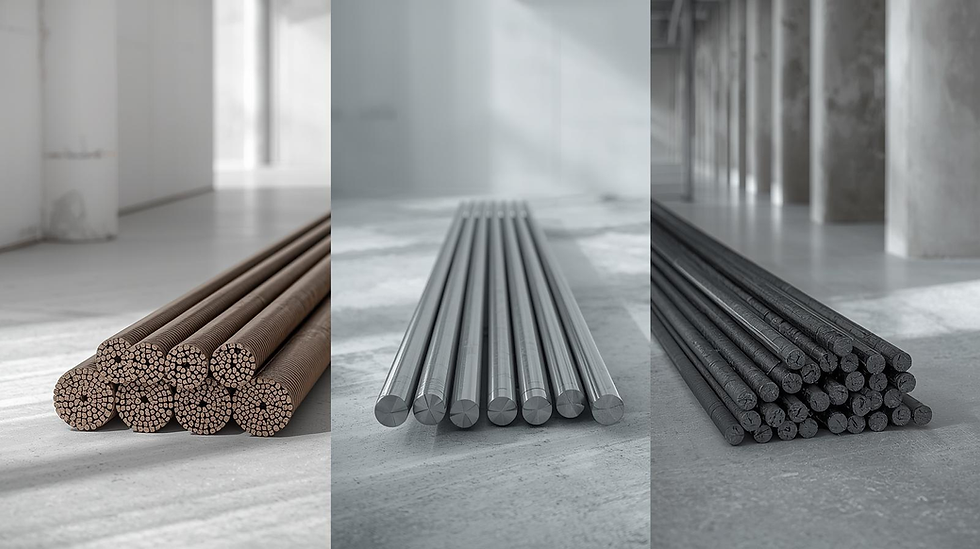How to Source Quality GFRP Rebar: Key Factors to Consider Before Buying
- Kamal Sharma
- Jul 16
- 3 min read
Updated: Aug 5
In the world of modern construction, strength alone is no longer enough. Durability, longevity, and resistance to corrosion have become equally important factors, especially when the infrastructure is exposed to moisture, chemicals, and coastal conditions. This shift has driven the demand for glass fiber reinforced polymer rebar. These GFRP rebars are rapidly becoming a preferred alternative to conventional steel reinforcement.
As an engineer, contractor, or builder, sourcing quality materials isn’t just a procurement decision, it’s a long term investment in the safety, integrity, and lifecycle cost of your project. But how do you know what defines a “quality” product in a relatively new and evolving category?
This blog breaks down the key factors you must evaluate before buying glass fiber reinforced polymer rebar. This makes sure your purchase meets the highest technical standards and performance expectations.
What is GFRP Rebar?
Glass fiber reinforced polymer rebar is made by combining continuous glass fibers with a polymer resin matrix, normally epoxy or vinyl ester, through a pultrusion process. This results in a lightweight, high-strength, corrosion resistant reinforcement bar, designed to replace traditional steel in reinforced concrete structures.
GFRP rebar is most commonly used in:
Bridges and flyovers
Marine and coastal infrastructure
Water treatment plants
Tunnels and underground utilities
Foundations in corrosive soils
Parking structures and decks
Things To Consider While Sourcing GFRP Rebars
Not all GFRP rebars are manufactured equally. Substandard quality can lead to:
Premature structural failures
Bonding issues with concrete
Reduced design life
Increased maintenance and repair costs
By sourcing high-quality glass fiber reinforced polymer rebar, you can make sure that your structure performs optimally for its entire intended lifespan.
Evaluate Manufacturer Credentials and Certifications
Before purchasing, always verify the credentials of the manufacturer or supplier. A trusted GFRP rebar manufacturer should comply with relevant international and national standards.
Always enquire for:
Factory quality certifications (ISO 9001:2015)
Product test reports from third-party labs
Technical data sheets with clearly defined mechanical properties
Working with a certified supplier provides an assurance your material has been tested for tensile strength, bond strength, modulus of elasticity, and thermal compatibility with concrete.

Inspect Fiber Volume Ratio and Resin Quality
The tensile strength and stiffness of glass fiber reinforced polymer rebar are strongly dependent on the fiber volume content. The higher the glass fiber content of the rebar (typically 70–80% by weight), the higher the tensile strength and stiffness.
At the same time, the quality of the resin matrix comprising of epoxy, vinyl ester, or polyester affects the:
Durability under high-moisture or chemical exposure
Thermal and UV resistance
Overall dimensional stability
Choose rebars with a high glass fiber-to-resin ratio and those made using moisture-resistant, UV-stable resins suitable for external applications.
Confirm Dimensional Consistency and Surface Treatment
Inconsistent bar diameters or warping can affect spacing, alignment, and concrete cover, resulting in poor bonding or cracking. Make sure that the rebars meet standard tolerances in terms of length, diameter, and roundness.
Unlike steel rebars, GFRP doesn’t rust and expand. Hence, proper bonding relies on surface treatments like:
Sand coating
Helical ribs
Indented surfaces
These treatments improve mechanical interlock with concrete. Always ask for surface type and test data on bond strength.
Analyze the Thermal and Chemical Resistance
GFRP rebar is often chosen for environments where steel can corrode. But not all GFRP bars are created equal in terms of chemical and thermal resistance.
Confirm that the rebar is ‘Tested OK’ for:
Alkaline resistance (for concrete compatibility)
Saltwater resistance (for coastal/marine projects)
Resistance to acids or sulfates (for wastewater plants)
High thermal stability (especially in fire zones or hot climates)
Opting for the right grade of glass fiber reinforced polymer rebar prevents premature degradation and structural failure.
Clarify Customization, Delivery, and Logistics
GFRP rebar typically cannot be bent on-site. Therefore, your supplier should offer:
Custom cut lengths
Pre-bent shapes (stirrups, hoops, hooks)
Clear bending radius documentation
They are more brittle than steel and require careful handling during transit. Check that the supplier:
Packages rebars in protective wrapping
Provides handling instructions
Offers technical support at the project site
Bottom Line
Glass fiber reinforced polymer rebar may seem like a small part of the overall construction cost, but its contribution to strength, durability, and structural integrity is monumental. If you are someone involved in construction, your decision to source quality GFRP rebar can significantly influence the project’s performance and sustainability over decades.
It’s not just about placing an order; it’s about asking the right questions, verifying credentials, and choosing suppliers who are committed to quality and transparency.
Because at the end of the day, what you put into the foundation is what stands the test of time.



Comments